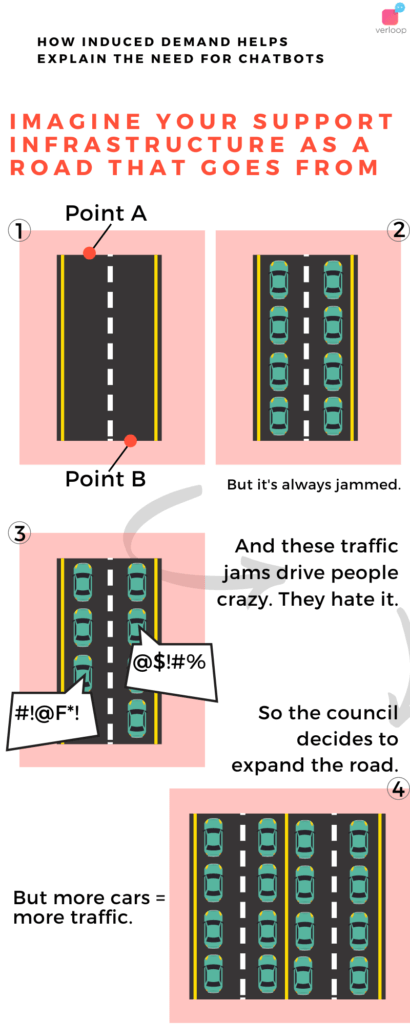Induced Demand – What Econ 101 Teaches Us About Excellent CX

Induced Demand – What Econ 101 Teaches Us About Excellent CX
On a cold, windy November night in 2019, my colleague and I sat in the Verloop office. The topic of conversation was the value prop of a chatbot – how do you explain to a client why conversational automation is worth the investment and why is it important for customer experience (CX)?
Selling automation of any sort is never easy. All the levels in an organization face significant resistance with the same.
Immediate capital expenditure costs are just the beginning. And as it turns out, explaining to people why global warming is real even though it snows every December is harder than it seems.
The following blog piece is an excerpt from that conversation – it aims to explain why shying away from automation (in this case conversational) is not only expensive but will also drastically hamper customer experience in the short and long run.
I’ve picked e-commerce as an industry to elaborate on my example. But, this can be expanded to any industry and any kind of automation.
Suggested Reading: Advantages of Chatbot for Ecommerce company
E-Commerce is the driving force behind many of the luxuries we enjoy on a day to day basis.
These billion-dollar companies leverage technology at every step of the commerce process. They source products for cheaper, make it easier for users to buy and make it quicker to be delivered.
The net result is hundreds of millions of products delivered every day across the world.
And, with this load also comes millions of customer queries. And hundreds of thousands of complaints.
Thus, brands need to answer queries and handle these complaints with care. 96% of customers who are subjected to high-effort experiences report being disloyal to the company in the future. And as Marketing Metrics points out it’s 6x easier to sell to an existing customer – so retention is key.
“Effort” here becomes –
- The need to contact a company more than once
- Support is a “generic” service and not personalized.
- Having to repeat information
- The customer’s perception that it takes additional effort to resolve an issue
And so while e-commerce firms use cutting edge technology in sourcing, warehousing, optimization, and delivery, they still use technology from the ’80s when it comes to customer support.
Customers’ support is offered through human reps who man emails, phones, and forms. Nothing’s really changed for the past couple of decades.
As they scale, all companies can do is add more agents, move to larger volume plans and rent out more call centers. But they still lag behind. They’re chasing a goal that’s seemingly endless in its scope.
Here, induced demand explains why. Consider this anecdote.
Imagine a two-lane road going from point A to B. Hundreds of cars plow through this road and it’s fairly regularly jammed. These traffic jams infuriate drivers and are a frequent cause of road rage. To solve the problem, the authorities expand the road to four lanes to ease congestion.

The authorities believe that this is a good idea. Of course, it is, they think, more lanes means more space for cars and less congestion. The lane expansion costs lots of time and money, but it seems worth it in the long run. But a funny thing happens. The traffic never really goes down - in fact, the number of cars on the road increase. And in time, the traffic comes back with a vengeance.
This phenomenon is called induced demand.
So, why did the traffic and the number of cars increase?
With the road expanded, the time to get from point A to point B by road decreases. People recognized that the road was a faster way to move around – and so more cars started taking this route.
Additionally, as more cars started using the road – the traffic increased. And the roads started getting jammed, even on four lanes.
So, Automation for customer experience?
This is induced demand- Which is, how more of a good is consumed with increased supply.
But, what does this have to do with customer experience?
Think of the cars in this anecdote as customers. They’re trying to get their customer query/issue resolved – moving from point A to B.
Furthermore, the road is your human manned email and phone support channels. Thousands of customers flood your channels every day. They’re constantly stuck, kept on hold and often lash out, tanking your CSAT and customer retention rates.
The knee-jerk reaction for C-level executives is to expand on their current offerings – spend hundreds of thousands of dollars to increase the number of support agents and seats.
Suggested: The Un-CEO Series – Samuel Gier, MilkBasket’s Herald of Success
This doesn’t work for two reasons –
- It assumes your customer base remains constant – which it won’t.
- Once users identify that calling is the easiest way to receive support – more people will start calling.
Hence, with more customers entering the fray every day, you’re investing in an empty effort.
To understand how to solve this problem – we go back to our road analogy. What does the local council really need to do to ease congestion?
Simply put – invest in a metro-line/subway system.
Thus, by improving public transport, the council gives people a faster way to get from Point A to B.
As people realize they don’t have to sit in traffic jams to move around – they start leaving their cars at home and opt for public transport.
Fewer cars on the road mean lesser congestion for those who NEED to travel by car.
A metro-line and/or subway system allows for quick transit from Point A to B for everyone else.
Companies need to get their customers off emails & phone calls. They need to move them to a faster, more automated system of support.
Suggested Reading: To improve CX, start with an improved agent experience
Enter, chatbots.
A Chatbot allows companies to automatically handle, solve, and close customer queries. By providing your customers with quick and timely support, you ensure that all your customers get from Point A to B immediately.
So, this reduces your load on manned systems like email and phone support. These channels are now freed up to service customers who NEED human intervention.
Chatbots empower brands to leverage their manpower to handle complex tasks – while letting the bot handle repetitive support queries.
Plus, chatbots also scale easily. No longer bother with hiring, training, outsourcing or adding seats as you scale. Two clicks – and you move to a new slab. Your customers continue to have the great support experience they’re used to and your resources are freed up to handle complex customer queries.
And, chatbots also allow companies to reach customers on a platform they’re comfortable with – WhatsApp.
With its high open, read and reply rates, WhatsApp Chatbots can answer frequently asked questions, help customers track their shipments, schedule refunds, reengage abandoned carts and collect feedback.
Offer better support, drive higher conversions and reduce ticket volumes today, with a WhatsApp Chatbot by Verloop.






